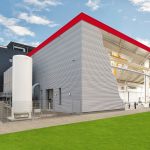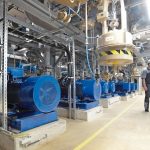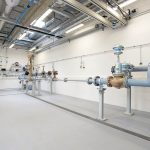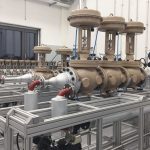Firmen im Artikel
Samson’s Global Innovation Centre at the company’s main site in Frankfurt (Germany) impresses with its sheer size, and its technical capabilities are no less remarkable. Besides prototype construction, a wide range of simulations and tests can be carried out on more than 7000 m2 of floor space.
New avenues in valve R&D, for example data analysis and cloud technologies, are presently being explored at the Innovation Centre in addition to traditional research topics such as materials science, fluid mechanics, cryogenics, acoustics, control engineering, device safety and system integration. Work at the Innovation Centre is focused on the digital transformation of Samson products.
“We are currently undergoing a radical evolution from manufacturer of iron products to seller of process intelligence”, emphasised Dr. Andreas Widl, CEO, at a press conference to mark the
Global Innovation Centre’s inauguration. The complex plant engineering and sophisticated digital infrastructure installed there are important foundations for this since they cover a wide variety of tests, process media and conditions and fields of application. At
the same time, they constitute an ideal starting point for research, development and testing of Samson products for any Internet of Things and Industry 4.0 environment. The entire infrastructure, which includes more than 200 test instruments, allows Samson to develop new prime-quality products very fast.
Simulations play a key role
“By incorporating simulation tools early on in the development process, it is possible to obtain detailed predictions regarding product behaviour”, said Dr. Thomas Steckenreiter, Samson Board Member for Research and Development since 1 June 2017. The company has created a very good environment for the R&D process by bringing together simulations and actual tests. Further along in this process, a prototype which was largely developed based on simulations is being subjected to real-life functional and wear tests. As prototyping is likewise integrated in the Innovation Centre, the economic viability of new products can be assessed at a very early stage in the development process. This provides essential information for implementation in series production, particularly when designing complex parts. Prototype construction relies on traditional machine tools, CNC machining centres and increasingly also additive manufacturing methods. As a result, key know-how about the latest manufacturing procedures is applied to the development of new products, paving the way for future innovations.
The digital infrastructure and systems installed at the Innovation Centre mean it is possible to perform real-time tests, including simulations of various plant and operating conditions. Process media can be simulated on different test benches in all conceivable states such as liquids, gases, vapours, multi-phase flows and even liquids containing solid particles. This is facilitated by the complex plant infrastructure with 5.5 MW of installed power and more than 250 valves of different sizes and with different pressure ratings, all made by Samson and its subsidiaries. Valves up to DN 500 in size for pressures up to 120 bar can be subjected to flow, acoustic and functional tests in the flow labs, where they can be calibrated and their operation simulated under specific plant conditions. All flow-relevant coefficients can be determined in this way.
Special test fields additionally enable Samson to investigate the devices in their application-specific environment, for example in cold-box applications of the kind encountered in air separation systems, which involve handling liquid nitrogen at cryogenic temperatures, or in self-operated regulators for installation in district heating and cooling grids.
Comprehensive lifecycle tests
Apart from their flow and control properties, another important quality indicator that characterises Samson products is the long service life, even under the most adverse process and ambient conditions. To achieve this durability, both the individual parts and the complete control valves are subjected to comprehensive lifecycle tests. Optimal maintenance intervals can then be predicted for different applications.
How long a control valve can withstand the conditions prevailing in a plant depends on a number of factors. The tests cover the materials’ chemical, thermal and mechanical resistance as well as their suitability for specific climates. In addition, the effects of different process and plant conditions, such as cavitation erosion or flow-induced vibration at closure members, must be taken into account. For this purpose, accelerated simulations can be performed on parts and entire devices made of metal or non-metal materials, in order to test their resistance to the many atmospheric conditions that exist around the world, for example in seawater environments. Further tests to verify corrosion resistance, as well as the thermal resistance of materials and compounds, are carried out by material scientists in various lab ovens and climatic cabinets.
Links to cloud platforms
The wide variety of control equipment and sensors in different sizes and styles installed at the Innovation Centre helps Samson emulate the complexity of customers’ actual plants. The signals transmitted by numerous pumps and control valves are recorded along with other variables such as pressure, flow rate, temperature, level, displacement, force, torque, conductivity and noise. All in all, the digital infrastructure comprises approximately 1700 signals in a networked measuring and automation landscape.
The sensor, control valve and maintenance data collected at the Innovation Centre is evaluated by Samson for analyses and visualisation. As a result, new approaches can be implemented for control, monitoring, diagnostic and safety tasks. The company additionally develops algorithms for valve diagnostics as well as predictive maintenance of control valves, processes, plant sections surrounding the valves and entire plant systems.
Thanks to the communication infrastructure installed throughout the Innovation Centre, test data can be archived in the usual way, but it is also possible to record real-time data through links to cloud computing systems. Apps yet to be developed, for example based on Samson’s own SAM Digital Hub platform, will open up new ways of automating process engineering plants.
Online search: cpp0118samson
Günter Eckhardt
Editor-in-Chief












